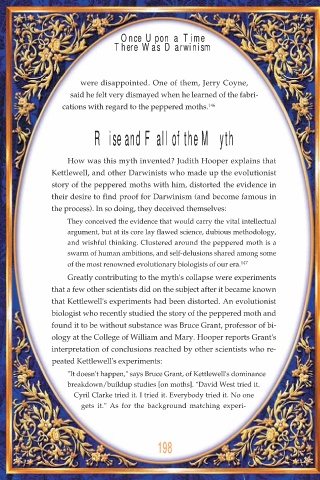Page 200 - Once Upon a Time There Was Darwinism
P. 200
Once Upon a Time
There Was Darwinism
were disappointed. One of them, Jerry Coyne,
said he felt very dismayed when he learned of the fabri-
cations with regard to the peppered moths. 146
Rise and Fall of the Myth
How was this myth invented? Judith Hooper explains that
Kettlewell, and other Darwinists who made up the evolutionist
story of the peppered moths with him, distorted the evidence in
their desire to find proof for Darwinism (and become famous in
the process). In so doing, they deceived themselves:
They conceived the evidence that would carry the vital intellectual
argument, but at its core lay flawed science, dubious methodology,
and wishful thinking. Clustered around the peppered moth is a
swarm of human ambitions, and self-delusions shared among some
of the most renowned evolutionary biologists of our era. 147
Greatly contributing to the myth's collapse were experiments
that a few other scientists did on the subject after it became known
that Kettlewell's experiments had been distorted. An evolutionist
biologist who recently studied the story of the peppered moth and
found it to be without substance was Bruce Grant, professor of bi-
ology at the College of William and Mary. Hooper reports Grant's
interpretation of conclusions reached by other scientists who re-
peated Kettlewell's experiments:
"It doesn't happen," says Bruce Grant, of Kettlewell's dominance
breakdown/buildup studies [on moths]. "David West tried it.
Cyril Clarke tried it. I tried it. Everybody tried it. No one
gets it." As for the background matching experi-
198

